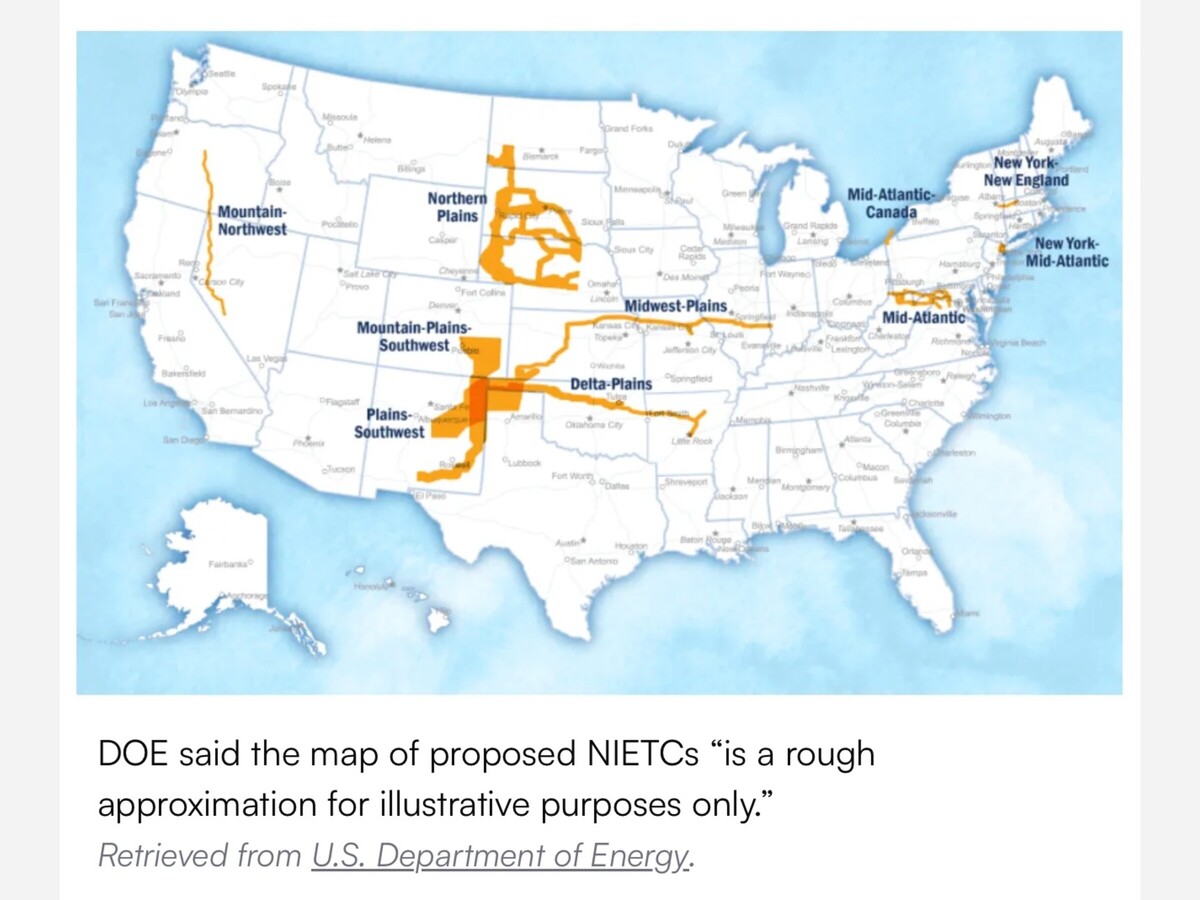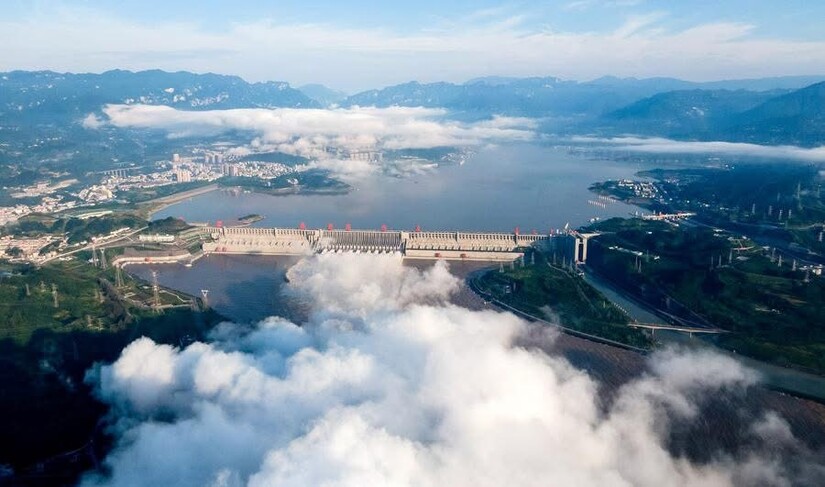Image


The U.S. Department of Energy has designated a significant stretch across Eastern New Mexico as a potential National Interest Electric Transmission Corridor (NIETC). Spanning between 3 to 15 miles in width, this corridor paves the way for transmission developers to build vital infrastructure for energy delivery and storage.
The 10 potential NIETCs, informed by DOE’s 2023 national transmission needs study, include:
Delta Plains: A 645-mile-long corridor spans portions of Arkansas and Oklahoma. This interregional corridor between the Southwest Power Pool and Midcontinent Independent System Operator could facilitate cross-interconnection transmission.
Mid-Atlantic: This proposed corridor consists of multiple parallel sections, each up to 180 miles long, within the PJM Interconnection in portions of Maryland, Pennsylvania, Virginia and West Virginia. It largely parallels existing 500-kV transmission facilities and could help meet future demand growth, DOE said.
Midwest-Plains: This potential 780-mile corridor in parts of Illinois, Indiana, Kansas and Missouri includes portions of an existing 345-kV transmission right-of-way and touches the PJM, MISO and SPP grids. The designation could help speed clean energy integration, DOE said.
Mountain-Plains-Southwest: The 540-mile long corridor, including portions of Colorado, New Mexico and Texas, could help address congestion between the Plains and Mountain regions that prevents delivery of affordable generation.
New York-New England: This 60-mile corridor in Massachusetts and New York includes sections of existing state highway and high-voltage transmission right-of-way. Development in the proposed corridor could help address potential electricity shortfalls that can occur during extreme weather, it said.
A complete list of DOE’s proposed NIETCs can be found here.
In many areas of the United States, the infrastructure required to deliver energy has not always kept pace with growth in demand. To improve energy delivery and enhance the electric transmission grid for the future, several government agencies currently are working together to establish a coordinated network of Federal energy corridors on Federal lands throughout the United States. Energy corridors would help address growing energy demand by facilitating future siting of oil, gas, and hydrogen pipelines and electricity transmission and distribution facilities, while also protecting the environment. As the agency-preferred siting locations, the energy transport corridors will provide industry and the public with greater certainty in infrastructure planning and will also speed development of future energy infrastructure on Federal land with the least impact
Section 368 of the Energy Policy Act of 2005 (EPAct) directs the Secretaries of Agriculture, Commerce, Defense, Energy, and Interior to designate, under their respective authorities, corridors for oil, gas, and hydrogen pipelines and electricity transmission and distribution facilities on Federal lands in the 11 contiguous Western States (Arizona, California, Colorado, Idaho, Montana, Nevada, New Mexico, Oregon, Utah, Washington, and Wyoming), to perform any required environmental reviews, and to incorporate the designated corridors into relevant agency land use and resource management plans or equivalent plans. Section 368 also directs the agencies to take into account the need for upgraded and new infrastructure and to take actions to improve reliability, relieve congestion, and enhance the capability of the national grid to deliver energy. EPAct also calls for identifying corridors in the other 39 states and to expedite processes for future projects in these energy corridors.
The proposed corridors, which total more than 3,500 miles across targeted regions, could unlock federal financing
What could this mean?
Heavy industrial transmission infrastructure and lines and battery storage for renewable energy could be developed within this area.
There are concerns from some organizations about the environmental and community impacts of these developments.
Eminent domain could come into play, allowing transmission developers, backed by the DOE, to acquire land needed for projects, even if it requires taking private property for public use within the designated corridor.
While this plan promises to enhance the nation's energy grid and support renewable energy growth a designated corridor could be troublesome with public participation in the process
Stay informed as this development progresses and consider the impacts it might have on the future of Eastern New Mexico and beyond.
Have Your Say: Voice Your Opinion on New Mexico's Energy Corridor!
The U.S. Department of Energy (DOE) has proposed the designation of a National Interest Electric Transmission Corridor (NIETC) across Eastern New Mexico, which could bring significant changes to the region's energy landscape.
Now is the time to speak up! Interested parties can submit comments and express their opinions on the proposed corridor using the following methods:
Submit via the Federal eRulemaking Portal:
Visit www.regulations.gov and search for docket number DOE-HQ-2024-0089 under the Potential Designation of Southwestern Grid Connector National Interest Electric Transmission Corridor.
Email:
Send your comments to NIETC@hq.doe.gov. Be sure to include the relevant docket number in the subject line!
Mail:
Send written comments to: U.S. Department of Energy
Grid Deployment Office
1000 Independence Ave. SW, Suite 4H-065
Washington, DC 20585
Other nations have created energy corridors with success. America needs investment in infrastructure and energy but public participation in the process is needed. The world’s largest clean energy corridor in China as an example has generated approximately 295.904 billion kWh of electricity, an increase of 7.11% over the same period last year.
This is equivalent to saving 89.24 million tons of standard coal and reducing CO2 emissions by 240 million tons.
With a total installed capacity of 71.695 million kW, the 1,800 km-long clean energy corridor comprises 6 mega hydropower stations on the Yangtze River.
 China's energy corridor state photo
China's energy corridor state photoWhereas in the US there has been opposition to this national strategy.
The U.S. Department of Energy is halting a project that generated pushback from property owners in Kansas and lawmakers at the local, state, and national levels. The plans included a proposed five-mile-wide energy corridor that would run through parts of the Sunflower State, including Russell County.
The Department of Energy’s original proposal included 10 electric transmission corridor projects nationwide. That has since been reduced to three and no longer includes the Midwest Plains Corridor that would have run from southwest Kansas through Illinois.
This is your chance to voice your thoughts on the potential impacts—whether it’s the construction of new transmission infrastructure, the use of eminent domain, or the development of renewable energy storage or development of oil or nuclear infrastructure. Your input matters as decisions about energy, land use, and community impact are made.